Cross-linked heparin coatings and methods
- Summary
- Abstract
- Description
- Claims
- Application Information
AI Technical Summary
Benefits of technology
Problems solved by technology
Method used
Image
Examples
example 1
[0077]FIG. 1 depicts a scheme for preparation of silyl-heparin. Treatment of benzylmagnesium chloride 1 with chloro(chloromethyl)-dimethysilane 2 gave benzyl(chloromethyl)dimethysilane 3 (n=1). 3 then underwent a repetitive reaction resulting in chain elongation. For chain elongation, treatment of 3n with magnesium gave the Grignard Reagent which was, in turn, treated with chloro-(chloromethyl)dimethylsilane 2 to give the homologous silyl compound 3 n+1. This Grignard reaction was repeated as needed to obtain the desired chain length for the silyl compound. At the desired chain length, 3 (or 3n) was treated with potassium acetate, followed by trans-esterification of the corresponding acetate with basified methanol to give the alcohol 4. The alcohol 4, when treated with triphosgene, gave the corresponding chloroformate, which on treatment with N-hydroxysuccinimide gave the N-hydroxysuccinimidyl carbonate 5. Heparin was conjugated to 5 in 1:1 DMF / H2O, where DMF is dimethyl formamide, ...
example 2
[0078]CARBOFLO® vascular graft material made of ePTFE with carbon impregnation of approximately 25-30% of the luminal wall by coextrusion (4 mm diameter) was cut to lengths of 8 cm. The grafts were immersed in acetone for 30 minutes at 37° C. until all air bubbles had disappeared and the graft “cleared” indicative of complete wetting. The grafts were transferred to an acetonitrile solution containing 0.34 mg / mL of bis-benzotriazole carbonate (polyethylene glycol) (molecular weight approximately 3.4 K daltons). The grafts were incubated in this solution for 30 minutes at room temperature. The grafts were then transferred to an aqueous solution containing 60% acetonitrile and 1.5% silyl-heparin of Example 1 and allowed to incubate for 1 hour at room temperature. The grafts were then rinsed in four serial changes of acetonitrile using a 15 minute incubation at each rinse. The grafts were then air-dried at 56° C. for at least 2 hours. The presence of heparin on the grafts was confirmed ...
example 3
[0079]CARBOFLO® vascular graft material (4 mm diameter) was cut to lengths of 8 cm. The grafts were immersed in acetone for 30 minutes at 37° C. until all air bubbles had disappeared and the graft “cleared” indicative of complete wetting. The grafts were then transferred to an aqueous solution containing 60% acetonitrile and 1.5% silyl-heparin of Example 1 and allowed to incubate for 30 minutes at room temperature. The grafts were transferred to freshly prepared aqueous solution containing 60% acetonitrile and 0.34 mg / mL of bis-benzotriazole carbonate (polyethylene glycol) (molecular weight approximately 3.4 K daltons). The grafts were incubated in this solution for 1 hour at room temperature. The grafts were then rinsed in four serial changes of acetonitrile using 15 minute incubation at each rinse. The grafts were then air-dried at 56° C. for at least 2 hours. The presence of heparin on the grafts was confirmed by staining with 0.01% aqueous dimethylmethylene blue and by use of a ...
PUM
| Property | Measurement | Unit |
|---|---|---|
| Fraction | aaaaa | aaaaa |
| Fraction | aaaaa | aaaaa |
| Fraction | aaaaa | aaaaa |
Abstract
Description
Claims
Application Information
 Login to View More
Login to View More - Generate Ideas
- Intellectual Property
- Life Sciences
- Materials
- Tech Scout
- Unparalleled Data Quality
- Higher Quality Content
- 60% Fewer Hallucinations
Browse by: Latest US Patents, China's latest patents, Technical Efficacy Thesaurus, Application Domain, Technology Topic, Popular Technical Reports.
© 2025 PatSnap. All rights reserved.Legal|Privacy policy|Modern Slavery Act Transparency Statement|Sitemap|About US| Contact US: help@patsnap.com



